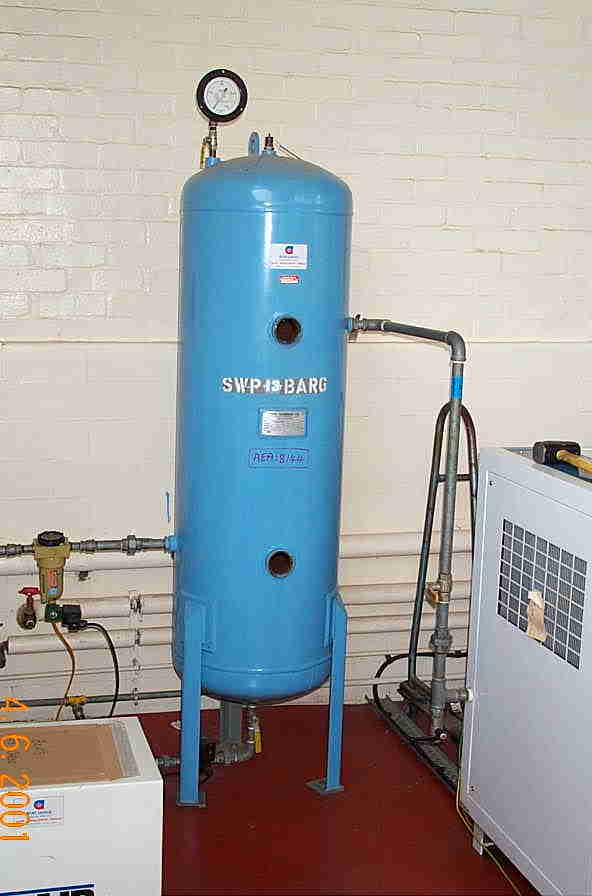NDT UPSKILLING KNOWLEDGE QUIZ
HERE’S THE ANSWERS
 Quiz Question 1. NDT codes
Quiz Question 1. NDT codes
Question: A common NDT technique for this vessel would be simple 0º compression probe (pulse-echo) UT thickness measurements to detect wall corrosion thinning on the inside surface. In which of the following areas of the vessel would you say that actual thinning (if it has occurred) is the least serious from an integrity viewpoint?
a)In the centre of the lower head, around the drain connection.
b) Near the head-to-shell welds
c) In the centre of the shell, well away from the ends and access ports
d) In the shell, opposite the air inlet pipe
The answer is (a), thinning is least serious in the centre of the head around the drain connection. This is because the head of a vessel is normally thicker than the shell and the pressure stresses are also lower, once you move away from the head-to-shell welds. Post-construction code API 510 confirms this by allowing you to calculate stresses in a thinned head in a modified way, as long as the thinning is in the central 80% x D (D-shell diameter) portion of the head. It therefore allows significant thinning before repairs are required. Incidentally, this area of the head does frequently corrode owing to water sitting inside the head, but that was not the question.
Learning points: Look up stresses in a vessel under internal pressure: circumferential(hoop) stress and longitudinal (axial) stress in the shell and see which one is the larger. Don’t worry about the more complicated ‘meridional’ stresses in the heads for the moment.
Have a quick look also at a general description of API 510 pressure vessel inspection code
Question 2. Defect acceptance criteria
Question: If you found visual undercut of 0.5mm deep and 10mm in length on one of the head-to-shell circumferential welds on this vessel, what would you recommend as appropriate next step?
a) Check it against the acceptance criteria of ASME IX or the EN welding code
b) Specify that it needs to be repaired
c) Specify a hydraulic pressure test to test the vessel’s integrity
d) None of these
The answer is most likely(d). You wouldn’t check it against ASME IX or EN equivalent as these are weld/er qualification codes, not pressure vessel codes. The amount of undercut found is most probably within the limits of the construction code and post-construction codes, so if you specified a repair it is unlikely your advice would be followed. A hydraulic test is not much use for checking the effects of undercut; undercut causes failures by acting as a crack initiator under fatigue conditions and these are not replicated by a pressure test.
In practice what you would do is first check the undercut against the defect acceptance criteria in the construction code and also a post construction code such as API 510.If it failed both of these (unlikely) then the next step could be a quick calculated fitness-for-purpose (FFP) study to API RP 579, or it might be easier to just replace the vessel. Air receivers like these are now cheap mass-produced catalogue items.
Learning point: Look up allowable weld undercut in ASME VIII-1 vessels. It allows undercut depth up to 10% of plate thickness or 3mm, whichever is the smaller. Other codes have similar limits.
Question 3. Factors of safety
‘Factor of Safety’(FOS) is a term relevant in the design and corrosion evaluation world, where it describes the actual strength of a component compared to how strong it needs to be. It also relates to wall thickness in pressure vessels where it gives an indication as to how much wall thinning the component can stand.
Question: On the air receiver shown, which component would you guess has the highest (best) FOS in its uncorroded condition?
a) The vessel heads
b) The vessel shell
c) The small-bore inlet and outlet pipes
d) The pressure gauge
The answer here is (c); the small-bore pipes. Heads and shells typically have a design FOS of 3 to 4. The pressure gauge would probably fail at lower than this. The small diameter (D) of pipes means that the governing hoop stress (you’d work it out using: Hoop Stress= PD/2t where P=pressure and t= wall thickness ) is much lower, giving a higher factor of safety. It can be up to 10, or even higher.
Learning point: Look up factors of safety and try to anticipate whether they would be high or low for the following items, before looking at the answers
- Crane hooks and ropes?
- Atmospheric storage tanks?
- Valve bodies?
The Answers are:
- Crane hooks and ropes? FOS of 7-10 is the norm.
- Atmospheric storage tanks? FOS perhaps 1.5-3; lower than you think.
- Valve bodies? Quite high due to their thick-walled cast construction. FOS of 5-7 as long as there are no metallurgical problems
How did you do?
You probably had a reasonable go at these using some engineering experience and intuition. You can see the idea, that as a discipline, plant integrity takes the results of NDT and then draws conclusion from them. To help draw these conclusions you need a good general appreciation of the issues surrounding plant integrity and how they fit together.
Fancy a few more questions?
Now that you have eased into the world of plant integrity have a look at our small plant surveyor quiz question set. If you’re starting to like the idea then go on to Interview questions for small plant surveyors.
DID YOU FIND THIS ARTICLE USEFUL?
Can we help you further?
We are not part of any government body, association, institution, agency or employer. Nor do we officially represent any of them, so you can be assured that we can provide you with an objective viewpoint. We can’t comment on individual companies and employers of course but are happy to discuss general asset integrity career situations or issues that you have.
We are always keen to discuss engineering and technical issues also, because that is what lifework careers in this industry are all about. Here’s some types of things may want to talk about:
- What roles can I do as an independent contractor?
- How suitable am I for a career move?
- I feel my career is going nowhere…what can I do?
- How relevant is a particular certification exam or qualification?
- What does a particular type of inspection/integrity engineer actually do?
- I have to prepare a presentation on Stress Corrosion Cracking (SCC). What should I put in it?
- What code should I work to for a welded repair on a pressure vessel?
Matthews Integrity Hub: HEAD OFFICE is OPEN EVERY DAY….0730 – 2200 Monday – Sunday…That’s correct, all week, every week, including holidays
 If we happen to miss your call, leave a message and we will call you back just as soon as we pick it up. Sorry, there’s no automated messages, call queueing, voice recognition tools or canned music. Try it and see.
If we happen to miss your call, leave a message and we will call you back just as soon as we pick it up. Sorry, there’s no automated messages, call queueing, voice recognition tools or canned music. Try it and see.
CONTACT US
Tel: 07746 771592 help@matthewsintegrity.co.uk





